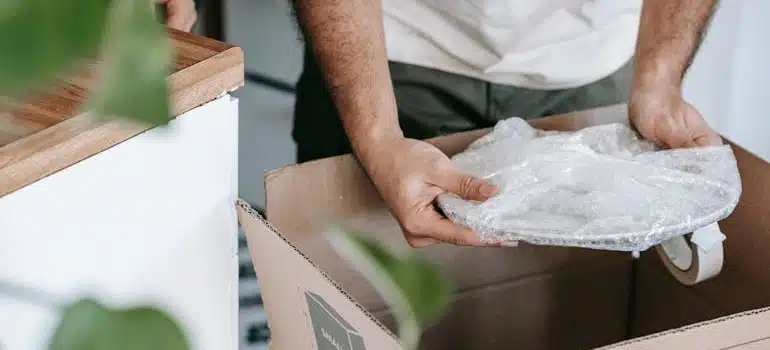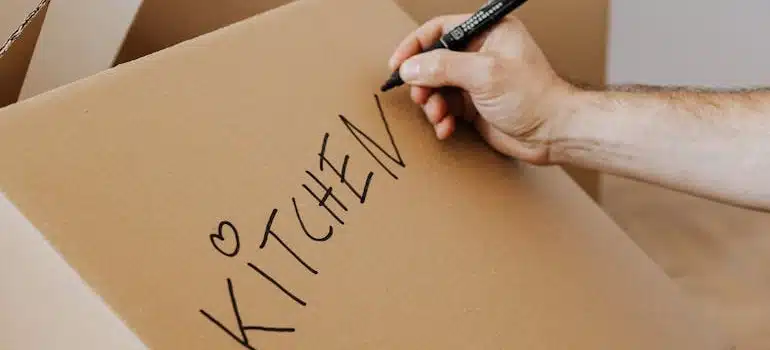Pack your kitchen for a long-distance move
Wondering how to pack your kitchen for a long-distance move in Florida? It’s a task that requires careful planning, especially for first-time movers. With delicate glassware, sharp knives, and bulky appliances, each item demands special attention. Using the right materials and techniques can ensure everything arrives safely. Here’s how our packing team at Pro Movers Miami recommends getting started.
Declutter your kitchen before packing begins
The first step in preparing your kitchen for a move is decluttering. Start by sorting through your cabinets, drawers, and pantry to get rid of unnecessary items. Relocation is a great time to donate unused gadgets, old kitchenware, and non-perishable food items to a local charity.
Be sure to discard anything expired, broken, or that you no longer use. That will lighten your load, save on moving costs, and ensure that you’re only transporting things you truly need. When you declutter your kitchen before a move, you’ll make the packing process much easier and more organized.

Gather the right packing supplies for kitchen items
Proper, quality packing materials are essential for protecting your kitchen items during the move in the Sunshine State. These are the supplies you’ll need:
- Sturdy boxes – Get boxes that are designed for heavy or fragile items.
- Bubble wrap & packing paper – For cushioning delicate dishes and glassware.
- Packing tape – To securely seal boxes.
- Dish boxes or cell dividers – These are great for safely transporting fragile items like plates and glasses.
Label each box clearly, writing “fragile” and indicating the room it belongs in, so it’s easy to unpack. You can even use color-coded tape for faster identification of kitchen items when unloading. The right materials will help keep your items safe and secure throughout the journey.
Start with rarely used kitchen tools and appliances
After securing packing supplies in Florida, begin with items you don’t use every day. This might include seasonal appliances like mixers, blenders, or slow cookers, as well as holiday dishes. It’s best to pack these first, so they’re out of the way.
If you still have the original boxes for your small appliances, use them to offer extra protection. For items that don’t have boxes, wrap them well in bubble wrap or towels for padding. Don’t forget to pack small appliances safely for a long-distance move. Wrap cords and secure loose parts inside the boxes, so nothing gets lost or damaged.
Pack dishes, glasses, and fragile items with care
Dishes, glasses, and other fragile items require cautious packing. Each dish should be wrapped separately in packing paper or bubble wrap to avoid any breakage. Plates should be stacked vertically, like records, as this reduces the risk of them breaking under the weight of other dishes. Fill any empty spaces in boxes with crumpled paper to prevent shifting during transit.
If you have wine glasses, stemware, or other delicate items, consider using a divided box to separate each piece. This will help prevent cracks or chips and keep glassware in place during storage and relocation. When packing dishes for moving, be sure to add padding around the items and label the box as “fragile” to ensure careful handling.

Keep pots, pans, and lids grouped together
Pots and pans are often heavy and bulky, but they can still be packed efficiently. To save space, nest pots together, placing a layer of bubble wrap or packing paper between each one. For lids, pack them separately, but make sure they are securely wrapped so they don’t scratch or damage other items. You can also use smaller pots to store utensils or spice jars, which helps conserve space.
Label these boxes as “heavy” to prevent overloading and ensure that they’re handled carefully. Packing pots and pans for a move may require extra attention, but with the right packing materials or reliable white glove packing help, they’ll arrive at your new home in perfect condition.
Create a “first-day kitchen box”
When you arrive at your new home, the first thing you’ll need is your kitchen essentials. To make the first day easier, create a first-day kitchen essentials box. Pack only the items you’ll need for your first meal and for basic kitchen tasks. This box should include:
- A set of plates, bowls, and utensils
- A cup, a glass, and a coffee mug
- A coffee maker, kettle, or other appliances you use daily
- Dish soap, sponge, and towel
- Snacks, bottled water, and easy-to-make meals
- Trash bags and paper towels
Packing these essentials in a separate box will prevent the need to rummage through multiple boxes when you need something quickly. Place this box last on the moving truck to ensure it’s the first one off.
Items to avoid when you pack your kitchen for a long-distance move
You should avoid packing certain kitchen items for a long-distance relocation because they can be fragile, hazardous, or difficult to transport:
- Open liquids or sauces (these can spill and cause damage)
- Perishables that require refrigeration
- Flammable items like cooking sprays or cleaning supplies
- Glass containers with contents still inside (they may break)
Keeping these items separate ensures that they won’t cause a mess or delay in your move. It’s better to consume or dispose of them before your move.

Label every kitchen box clearly and accurately
Labeling each kitchen box is essential for a smooth move. Use large, bold text on the boxes to indicate what’s inside or pre-designed moving labels. Be specific, for example, “Glassware – Kitchen,” “Plates – Fragile,” or “Pots and Pans – Heavy.”
You can also add handling instructions like “fragile” or “this side up” to prevent mishaps. Color-coded tape or stickers can also expedite the process, enabling you to quickly identify boxes containing kitchenware.
Prep smart to protect your kitchen gear
As you pack your kitchen for a long-distance move, make decisions based on what you’ll need in your new space. Avoid overcrowding boxes, and use specialized packing materials, such as dish packs, to prevent breakage.
When organizing your new kitchen, consider the layout when packing and group similar items together, as well as frequently used utensils in easily accessible containers. Focus on maximizing efficiency without rushing, allowing you to unpack and settle in quickly and without additional stress later.
